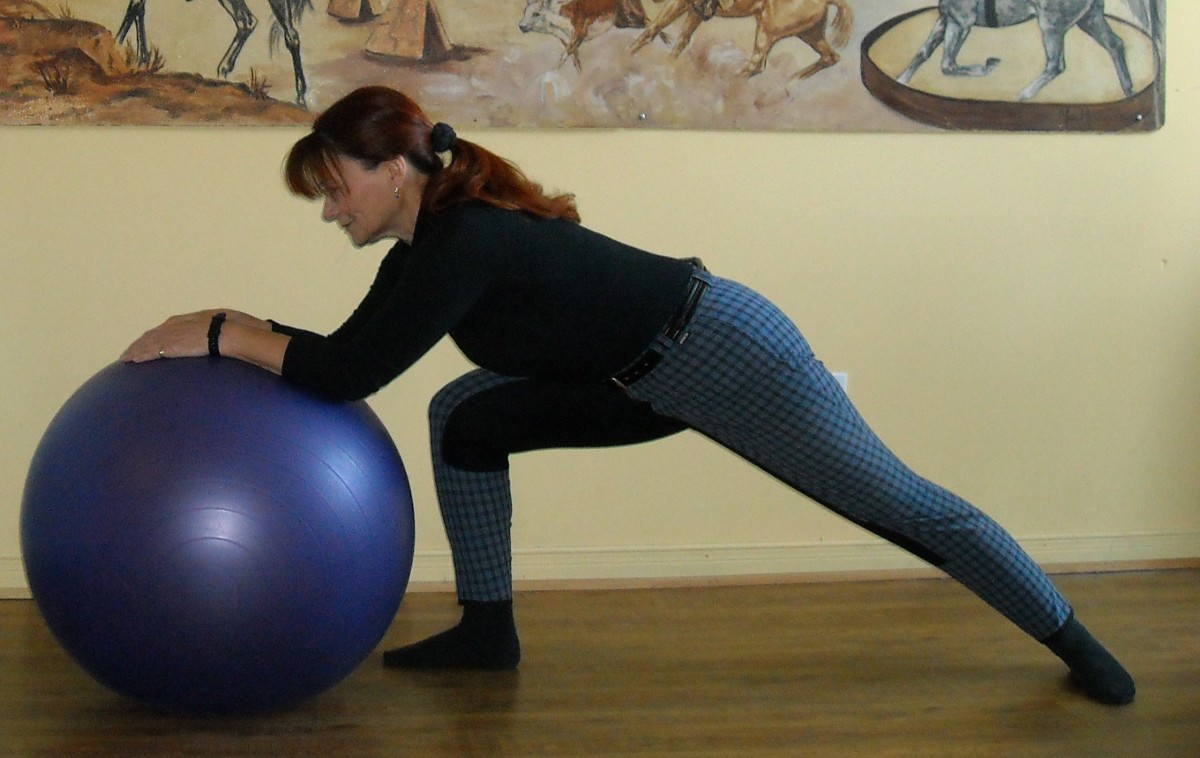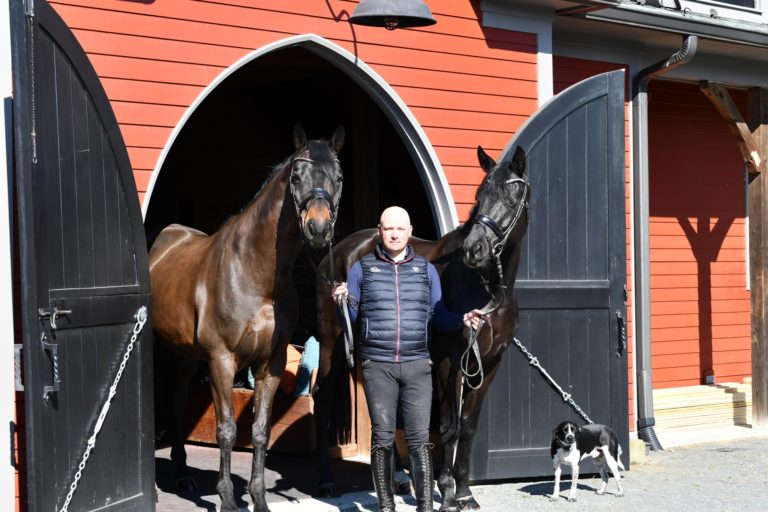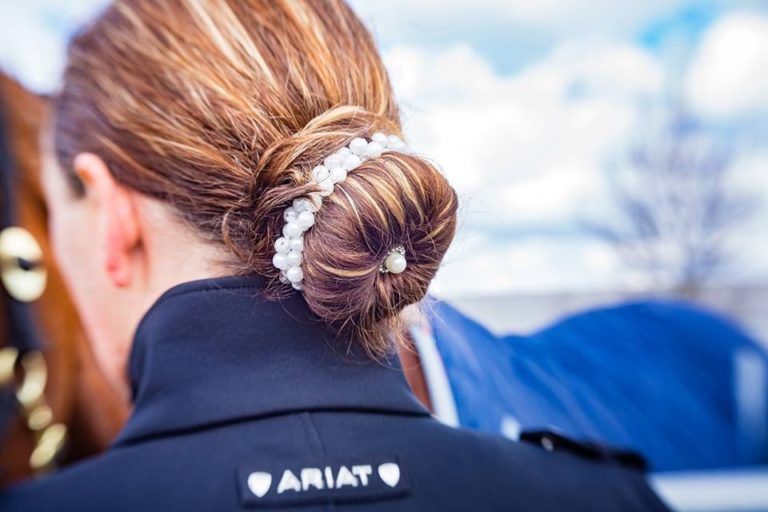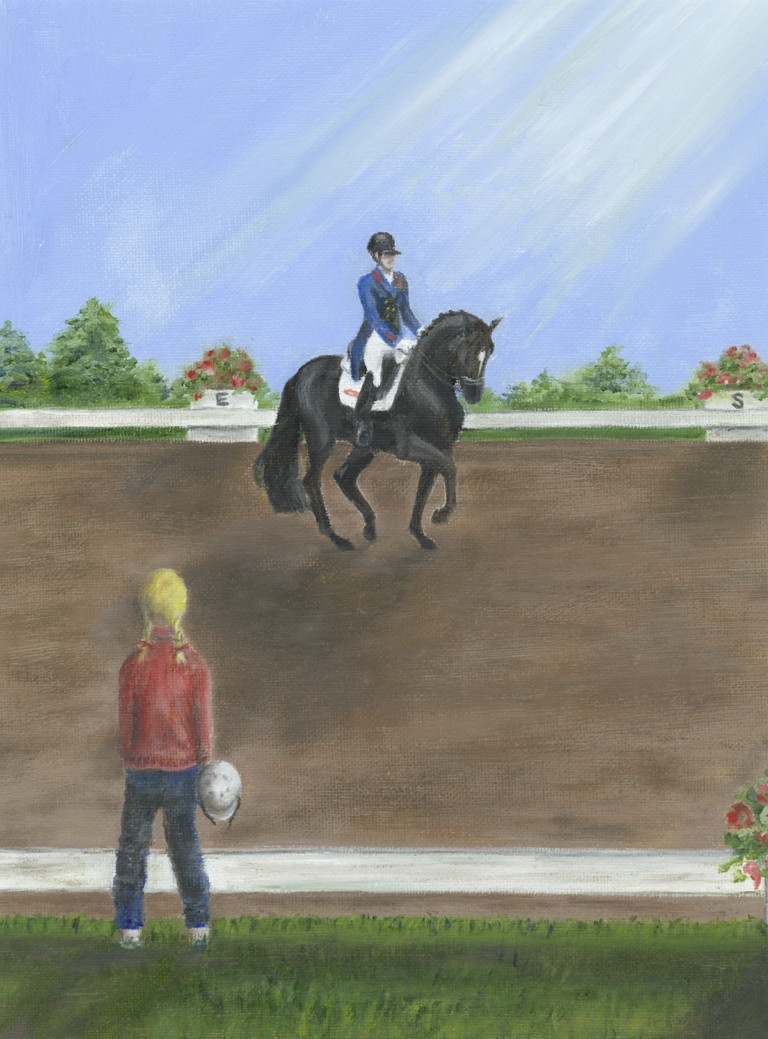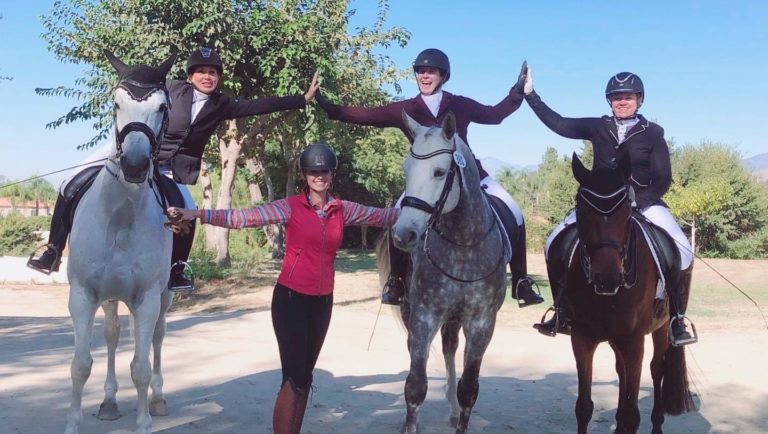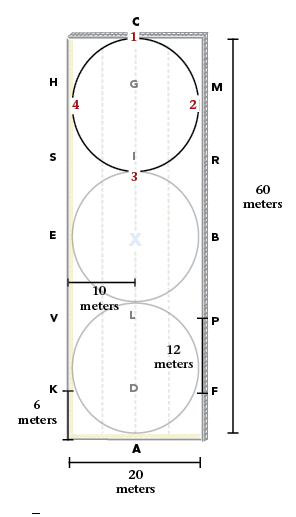Heather Sansom is the author of rider fitness ebooks Complete Core Workout for Rider, and a regular columnist in several equestrian publications including Dressage Today.?EquiFITT.com offers rider fitness clinics & workshops, Centered Riding? instruction, and convenient distance eCoaching for riders anywhere.? Subscribe to receive free monthly Equestrian Fittips, and download rider fitness eBooks at:? www.equifitt.com/resources.html
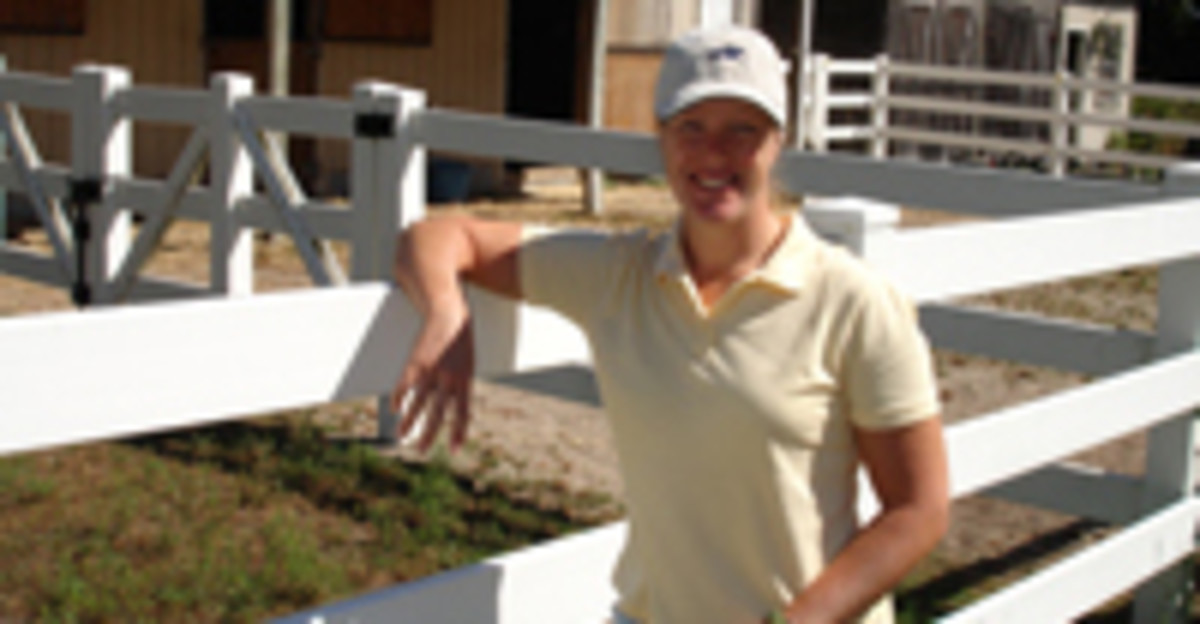
I frequently get asked why a rider’s lower leg flops in and out.? There are many reasons that depend on the rider/horse pair: one answer cannot solve the problem in all cases.? However, I have noticed some patterns.? If a rider is reaching for the stirrup with their toes and cannot settle the ball of their foot comfortably into the stirrup, then the rider has likely not earned the right to a longer stirrup.
Throwing the stirrups down before the riders’ body is ready to follow is a little like throwing your reins away on a hot horse with a tense back.? Instead of following the bit, his head is likely to go up, and you will no longer be able to feel what he is going to do next with his head.? It is better to keep contact.? The rider’s leg has to be ready to lengthen down through the heel so that proper weight and connection will be in the ball of the foot in the stirrup, and spring will be in the ankle, knee and hip.? If the rider is reaching for the stirrup, they will have tension in their legs and joints which will cause them to block the up/down motion of the horse’s back, and send their feet in and out instead.? The problem is not really long stirrups.? It is tension in the rider’s legs and joints which is not allowing the leg to lengthen and softly allow the motion of the horse in the vertical plane.? If the rider had a shorter stirrup and better contact, it might help them relax their leg, establish good muscle patterns and the appropriate balance legs that do not interfere, but can control accurately.
In the diagram the lines representing the rider’s thighs and lower leg are exactly the same length.? However, the left side appears shorter.? This is what you see on a live rider who is not ready for longer stirrups: they will tend to show knees creeping up, inner thighs pinching the horse, and a more raised heel making the leg look shorter.? The physical length of a rider’s leg is not as important as how the rider is using it.? I often like to refer to world class Olympian Debbie MacDonald when a rider tells me they cannot have a nice leg because of DNA.? Height and body typing are not as relevant to riding as body balance, carriage and usage.

If the rider is reaching for the stirrups and not relaxing their thigh around the horse, there will be a certain amount of tension in their position which is worsened as the horse moves.? They tend to squeeze the inner thigh for balance, which raises and turns the knee in and locks the hips.? That inward force blocks the energy that should be going nicely through the horse’s latissimus dorsi and longissimus muscles along his back.? Think of it like pinching the horse with a clothes-pin behind his shoulders and withers.? His movement will become less smooth, which will make sitting even more difficult.? Combined with lack of secure stirrup position, the rider’s brain will trigger the rider’s legs to tighten even more for balance.? It is a perfect vicious circle of mutual reaction- a kind of biomechanic co-dependency.
Since the rider is not absorbing the horse’s motion through their pelvis and leg joints (knees and ankles) softly, there will be an excess of energy which has to escape somewhere.? I usually see it go up, down or both directions.? If the energy travels up, the
rider may have excessive motion in their lower back (forward and back).? When it travels down, they will have a noticeably floppy lower leg that flaps in and out with every stride (energy escaping horizontally).? If the rider has a particularly relaxed ankle, sometimes the energy can escape in excessive motion in the foot only while the rest of the leg appears calm- even if tense.
Since the horse cannot move on the vertical plane properly with energy cycling up over his back through to his mouth, the horse may start to move with energy escaping horizontally as well (swingyness) which further feeds the rider’s horizontal inefficiency.
A rider may try and fix the problem by shortening the stirrup and jamming the heel down.? Since the problem is mechanical (tension) not cosmetic (position of heel), the problem is not fixed by jamming heels down.? Heels fall down softly in response to the stirrup bar being raised with the saddle up under the rider.
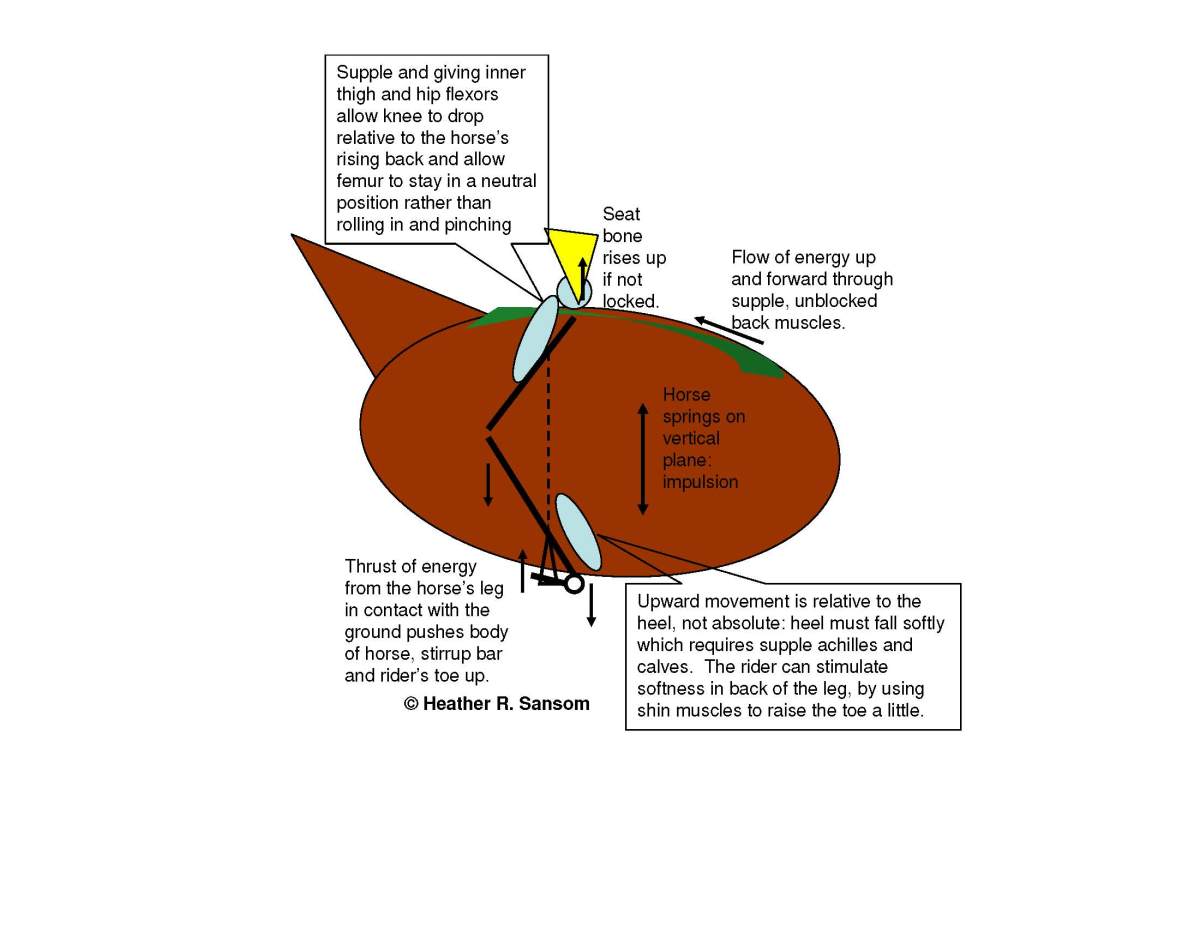
Tension in joints is often the body’s response to a lack of strength balance.? When muscle strength is not balanced across a joint, the stronger side ?wins’ and tends to pull the limb toward itself.? An example is the frequent inner/outer thigh imbalance in riders which triggers the brain to use the inner thigh more than it should or needs to and assists the rider in tumbling into the vicious circle of pinching too much with their inner thighs/tightening their hip flexors.? When a rider tries to shove their leg out of this dynamic, the result can be a painful feeling in the hip flexors or a cramp in the out thigh.? Balancing the body off horse would be a more effective way for the rider to create symmetry across the hip joint, and train their neuromuscular connections which control the ?on/off’ switches to their inner thigh muscles.
The second factor in tension is often simple lack of strength.? When a rider does not have balanced or sufficient muscle fiber, the body will try and create stability by tightening ligaments and fascial tissue.? Very stiff ankles can be softened with stretches that are held long enough to benefit both the calf muscle which may be tight, and the other soft tissues such as the Achilles tendon.? The logic is almost counterintuitive.? A rider with better co-ordination and strength balance in the lower leg and feet, will be better able to relax their ankle, provided they train suppleness appropriately with a balance of strengthening and lengthening exercises.
If you have a tendency to floppy lower legs, increase the suppleness of your hip flexor / inner thigh muscle groups, and your calves and heels while building a little more strength in your lower legs so that you can comfortably set and maintain your foot position with softness in the ankle and thigh.
Hip Flexor & Heel Stretch Using Ball
Step 1: Using the exercise ball to support your weight will allow your body to relax as you lengthen the distance from the front of your pelvis to your heel to stretch the hip flexors.? The rear foot is turned out slightly to rotate the femur outward so that the stretch also moves into the inner thigh group.
Step 2: Raising your hip position slightly so you can press your heel back will create a nice long stretch through the entire chain of muscles and tissues running down the back of your leg to the bottom of your foot.? The rear foot should be facing directly forward.? Many people with tight ankles will notice their body cheat on them by turning their toes out to avoid having to stretch the area.
EquiFITT.com offers rider fitness clinics & workshops, Centered Riding? instruction, and convenient distance eCoaching for riders anywhere.? Subscribe to receive free monthly Equestrian Fittips, and download rider fitness eBooks at:? www.equifitt.com/resources.html
